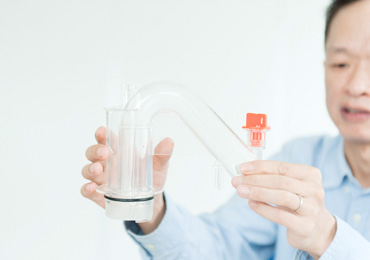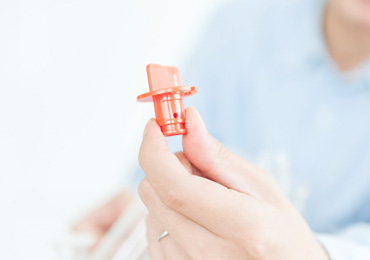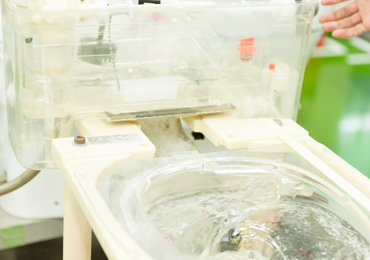Did you know that there are two types of public toilets — the flush valve system and the flush tank system? While the flush valve system can be used frequently at short intervals, the tank system is better at conserving water. TOTO’s new product for public toilets is an innovative new system combining the strengths of both types, with water-saving and user-friendly capabilities built in. Destined to become the standard for public toilets in the future, the new system represents a radical evolution in the tank system. How does it control the momentum of flush water? What challenges did engineers face in developing the ultimate public toilet? This Green Story unveils all the details.

Kenichi Nakamura
Sanitaryware Development Section No. 2
Sanitaryware Development Department
Nakamura joined TOTO in 1996, and had been developing toilet bowls for 14 years. In 2010, he was dispatched to the development department of TOTO U.S.A. Since returning to the Sanitaryware Development Department in Japan, he has been engaged in the development of public-use products.


“I redesigned all the parts in the tank, too,” says Nakamura.
“Since I started with TOTO in 1996, I have developed toilets. I was involved in the development of the Tornado Flush, and I’ve called myself a “toilet bowl development expert.” However, when I came back to Japan after working in the R&D department of TOTO U.S.A., my boss told me to develop a public toilet, especially the tank system for it. To be honest, I thought, “Why should I do that?” However, as he explained my new mission, I began to think it could be interesting. I was assigned to lead a big project to develop a completely new, next-generation tank from scratch. As a toilet bowl development expert, I had taken on a lot of challenges, but I’d not thought about improving the tank very often. Certainly, the higher the tank performance, the more water can be saved, and that concept should have made it easy for us to develop a better toilet. So I made up my mind to work on the new project. At the time, I had no clue I would be facing challenges beyond my wildest imagination.
↑ page top


A transparent model of the new downsized tank, a very elaborate work.
“Our goal was to create a system that combined the strengths of the flush valve type and the tank type. The flush valve directly connects to the water pipe, is compact and used repeatedly at short intervals, but it is hard to install. The tank type often found in residences is more water saving and easier to install, but it takes about 60 seconds to fill the tank after each flush, so is not appropriate for public toilets used by many people. Therefore, I came up with the idea of making the smallest tank possible, which could be filled quickly and used at short intervals. More than that, it should save space in the stall and be easy to use in a small space. By replacing the flush valve with the tank, more water could be saved. In other words, we began considering how to create a new standard for public toilets.
“Making a smaller tank was far from easy. Conventional tanks operate by flushing the toilet using the force of gravity, so the water has to be stored in tanks that were large enough and higher than the bowl. We aimed to reduce the height of the tank by 30%, meaning that we would have to use other means than gravitational force to provide momentum. In addition, while 4.8 liters of water is considered necessary to flush, the tank was designed to store only 3 liters, so 1.8 liters would have to be supplied instantly via the water pipe. Eventually, we devised an innovative method called the jet pump system that amplifies the power of water. The system projects powerful jets of water from the water supply via the thick pipes in the tank, and the jets for the tank water provide a momentum four times stronger than usual. However, the powerful jets are not water saving, so they had to be controlled. This was a tremendous challenge. In addition, the system should be power-free. This was to be the first time anyone had ever tried to invent a jet pump flushing system that controls the water without electricity. And we understood why — it was not easy.

You see how small the new tank (right) is by comparing it with the old model.

This thick pipe is the most important part for the jet pump.
↑ page top

“We devised the idea of using air in the jet pump system. We actually did not want to use air in the system, if possible, because it would make it impossible to fully use the momentum of the jet water. We struggled to find the most appropriate amount and timing to inject air into the water during the 6 to 7 seconds of a flush, in order to achieve an improvement in water savings. In fact, it was a battle with the air. Under intense time pressure — we had to achieve results in 18 months — we made more than 30 models in the process of trial and error to find the right volume and timing of air injection. We found that the air inlet was the key to the system, and even after its essential performance was achieved, we never ceased to improve it until we finally could do nothing more – we had redesigned and downsized every part, refining their every detail.
“This new tank is one of the most innovative designs we have achieved. For example, after every flush in a conventional flush valve system, a little bit of water trickles out, and that is a great enemy of water-saving performance. However, with the air-injected jet pump tank, there is never a trickle. The noise of the flush also stops immediately. In addition, the tank stores less water so that it can be flushed every 20 seconds or so. Just like Tornado Flush for toilet tanks, this has become one of the most revolutionary products in TOTO’s history.

The air inlet, which was the biggest challenge for Nakamura during development, became the most innovative part in the whole system.

The design of the extremely small tank was decided after exhaustive trials.
↑ page top


We tried to create the strongest and most durable lever.
“After the hard struggle of downsizing the tank, we faced another challenge – durability. “The new tank had already passed all domestic-use durability tests, but for public toilets, the possibilities of encountering problems are much more frequent. For example, someone may get on top of the tank or kick the handle. Public durability often depends on whether the users have good manners, and this makes it difficult to pinpoint which durability tests should be conducted. Even when we would have thought no one would abuse toilets in certain ways, our senior colleagues would say, “Okay, why do you think that’s impossible?” (Laughs.) Therefore, our team did field research. We conducted surveys at railroad stations, highway service areas and convenience stores. As a result, we discovered that the intentional destruction of public toilets in Japan is rare. However, we decided to address the dangers of extra loads on top of the tanks. Even if no one was climbing on them, someone might damage them by putting very heavy bags on top.

For public toilets, the bottom of the tank was reinforced by lining it with a steel sheet.
“To downsize the tank, we used plastic materials. To make it thinner with a precision shape, plastic is better than ceramic. However, we needed to find a good way to reinforce the plastic against a heavy load, as safety is one of the most important issues. So many parts had already been installed in the tank, and the tank also had to store at least 3 liters of water. Eventually, we enhanced the lining to prevent condensation and reinforced the upper part of the tank from the inside. In addition, we invisibly reinforced the bottom of the tank by lining it with a steel sheet. We faced all these challenges because we were developing a public toilet, and they turned out to be very interesting, after all. We had a good experience seeking solutions and experienced the best parts of developing a product. Thanks to our team’s endeavors, we developed the best tank ever. We’re sure that the flush tank system with the special flushing device will become the basis for the flush system of the future. We hope that by the 2020 Tokyo Olympics, it will have become the standard for public toilets. I’m sure it will. We have a great deal of confidence about that.
↑ page top














